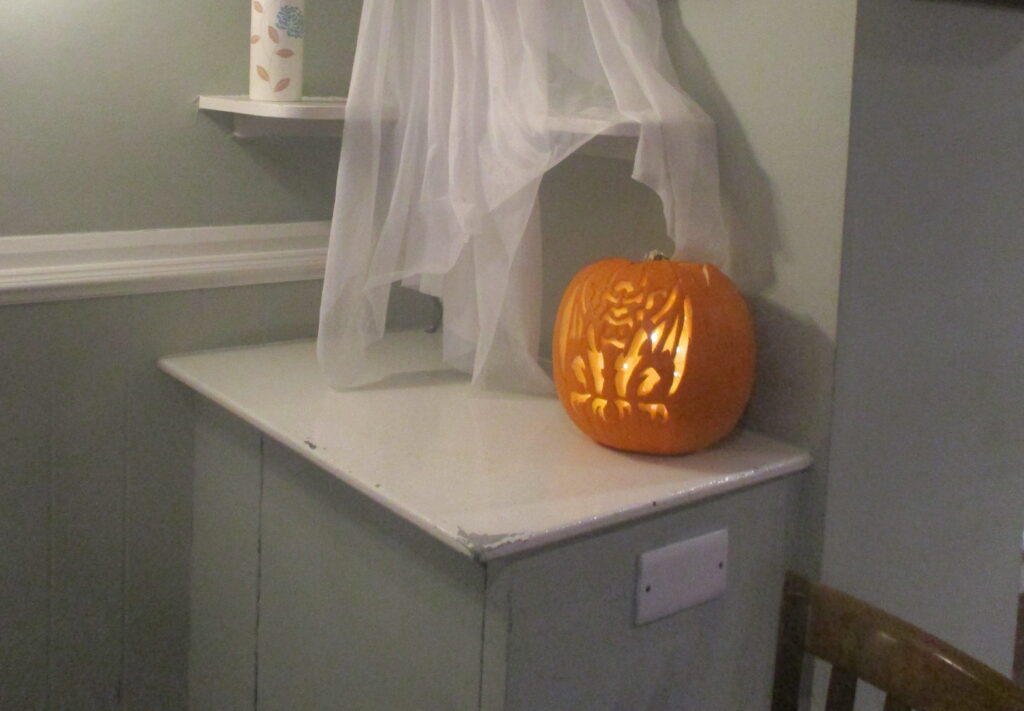
Halloween decorations, Black Bull, Wetherby, West Yorkshire. Mtaylor848, CC BY-SA 4.0, via Wikimedia Commons.
While every story in Meng Jin’s Self-Portrait with Ghost is eerie—as the collection’s title might suggest—the eeriest is the one about three babysitters. “Three women,” the narrator remembers, then corrects herself: “three girls,” though all older than she was. As a child she thought of them as the pretty one and the wicked one, both of whom she loved, and the boring one, whom she disdained. When she grew up and went to college, she found she couldn’t really see her own body except when she compared herself to other girls—whether “ugly or pretty, beautiful or gorgeous, if she was plain but sweet, if I wanted to look like her or not.” Boys, too, she evaluated by proxy: if his girlfriend was pretty, he was desirable. What she didn’t know was that, at the same stage of girlhood, her three original models were already vanishing into women—defined no longer by their own prettiness, wickedness, or dullness, but by the common objectification of their bodies, the varieties of violence done to them, and their differing abilities to stand it.
—Jane Breakell, development director
I don’t scare easily, but the Latvian artist Julia Soboleva’s I have found the light in the darkness terrified me. In her monograph, which features paintings and collages made of old photographs, Soboleva conjures up an eerie underworld inhabited by birdlike creatures. In one image, a group of weeping doctors with bird heads gather around a surgical table and use pliers to operate on a bleeding human leg. In another, two creatures carry a dead body on a stretcher while a third one watches, smiling. But what’s most disturbing about the book is how, at times, these hybrid animals seem ordinary, even human. They give birth, dance in the park, make out, and meditate; they pose for pictures with their loved ones, and they seem happy. Soboleva’s rendering of this ghostly world in images is so clear that it’s as if these strange creatures have always lived right beneath our feet, and she is finally allowing us to see them.
—Clarissa Fragoso Pinheiro, intern
Here is something you can do if you’re feeling bad and you want to feel not exactly worse but are not quite ready to feel better: watch all three Godfather movies back-to-back in a forty-eight-hour window. Then you can watch some other movies, more or less in descending order of quality—The Departed, The Friends of Eddie Coyle, Mystic River, and, if you can get it on DVD, State of Grace, starring Sean Penn. People often ask me why I won’t watch anything but mob movies and I have never had a good answer beyond my basic, mostly uninterrogated preference. But part of what I like, I think, is watching the magnification of everything horrible about being in a family or any kind of network of loyalty, beyond the point of the absurd, beyond the point of the grotesque, far beyond the pale.
—Sophie Haigney, web editor
I am always searching for terrifying but artful films without too much body horror. I have never been able to finish David Cronenberg’s Videodrome or Crimes of the Future (too gory), but I had my eyes glued to the screen during his lesser-known, less gross Dead Ringers (1988). In this psychological thriller, Cronenberg offers a chilling contribution to the long line of art about twins and doppelgängers, like Dostoevsky’s The Double and David Swift’s The Parent Trap. Based on the real lives of Stewart and Cyril Marcus, Dead Ringers follows Beverly and Elliot, identical twins who share a gynecological practice, an apartment, and sometimes even lovers. Beverly, who is awkward, warm, and introverted, does the medical work at the practice; Elliot, suave, cold, and social, charms his female colleagues and strangers. Jeremy Irons plays them both, calibrating their tortured personalities so brilliantly that with no other clues you can tell from just his posture and gaze which brother is which. They frequently trade places with each other, a calculated deception which works perfectly until they both become addicted to prescription pills and lose control over their performances. As their dissolution accelerates, Cronenberg oscillates between the two settings in which each brother is most in his element—a bleak Reagan-era workspace and lush bourgeois parties—with increasing frequency. The first time I watched the film, I cried in front of all my friends and was unable to articulate why. The second time I watched it, I realized, to my horror, that I identified with both of the brothers. The brilliance of the film is that the twins have split themselves into the public and private identities of a single person. They are caught in a dance, performing until the point of collapse.
—Campbell Campbell, intern
from The Paris Review https://ift.tt/mpDSqt3
Comments
Post a Comment